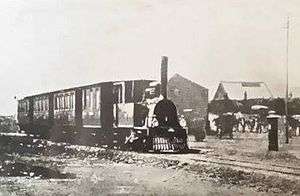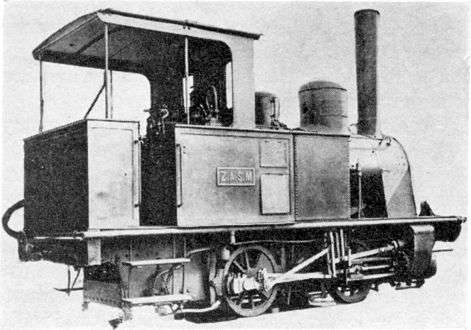NZASM 14 Tonner 0-4-0T
|
No. 1 Transvaal at the Outeniqua Transport Museum, 15 April 2013 | |||||||||||||||||||||||||||||||||||||||||||||||||||||||||
| |||||||||||||||||||||||||||||||||||||||||||||||||||||||||
| |||||||||||||||||||||||||||||||||||||||||||||||||||||||||
| |||||||||||||||||||||||||||||||||||||||||||||||||||||||||
| |||||||||||||||||||||||||||||||||||||||||||||||||||||||||
The NZASM 14 Tonner 0-4-0T of 1889 was a South African steam locomotive from the pre-Union era in Transvaal.
In 1889, the Nederlandsche-Zuid-Afrikaansche Spoorweg-Maatschappij acquired its first locomotives for use on the new railway which was being constructed from Johannesburg to Boksburg. Since the railway classified its locomotives according to their weight, these well-and-side-tank locomotives were known as the 14 Tonners.[1][2]
The Randtram line
As a result of the rapid development of the goldfields on the Witwatersrand in the 1880s and the demand for coal by the growing industry, the Volksraad of the Zuid-Afrikaansche Republiek (ZAR), also known as the Transvaal Republic, granted a concession to the Nederlandsche-Zuid-Afrikaansche Spoorwegmaatschappij (Netherlands-South African Railway Company, NZASM) on 20 July 1888 to construct a 16-mile long (26-kilometre) railway from Johannesburg to Boksburg. The line, which was opened on 17 March 1890, became known as the Randtram line, even though it was actually a railway in every aspect and not singularly dedicated to tram traffic. This was the first working railway in Transvaal.[1][2][3][4]
The concession was extended the following year to continue the line eastwards to Springs, where coal was known to exist, and westwards via Roodepoort to Krugersdorp. The entire 49-mile long (79-kilometre) line was opened to traffic on 10 February 1891.[1][2]
Manufacturer
In 1889, five well-and-side-tank locomotives with a 0-4-0 wheel arrangement, the first locomotives of the NZASM, were obtained from the German engineering firm and locomotive builder Maschinenfabrik Esslingen, owned by Emil Kessler. Since the NZASM classified its locomotives according to their weight, these engines were known as 14 Tonners. They were erected at Elandslaagte near Johannesburg, now the city of Germiston. The engines were numbered in the range from 1 to 5 and placed in service on the new railway to Boksburg.[1][2]
Characteristics
Their cylinders were arranged outside the plate frames. The Murdoch's D slide valves, mounted above the cylinders, were arranged at an incline and were actuated by Allan straight link motion. In this type of valve gear, the valve rod and the expansion link are respectively connected to opposing arms on the reversing shaft, so that partial rotation of the shaft moves the link and the die block in opposite directions.[2]
Apart from the side-tanks, the locomotive also had a well-tank between the frames under the boiler barrel. The dome was on the front section of the boiler and the regulator valve was arranged in the smokebox.[2]
Service
NZASM
As the Randtram line was expanded to the west and east to become the Reef line between Roodepoort and Springs, the 14 Tonners remained in service on that line, even though their range of operation was somewhat limited by their small coal and water carrying capacities.[1][2]

The first locomotive, no. 1 named Transvaal, entered service on 18 July 1889. It hauled the first train on the Randtram line when it was opened on 17 March 1890 and was retired in December 1903, by which time it had covered a distance of 113,309 miles (182,353 kilometres).[1]
Imperial Military Railways
All railway operations in the two Boer Republics, the ZAR and the Orange Free State, were taken over by the Imperial Military Railways (IMR) during the Second Boer War. The IMR renumbering register made provision for all five 14 Tonners in the number range from 601 to 605, but it is not known whether all five were actually renumbered.[5]
Central South African Railways
_IMR-CSAR_438.jpg)
At the end of the war, when the IMR was transformed into the Central South African Railways (CSAR), either three or four of the 14 Tonners survived and were renumbered, either from CSAR numbers A to C or from A to D. The uncertainty arises from the fact that the renumbering register lists CSAR no. D as both NZASM 14 Tonner no. 5 and one of the NZASM 18 Tonner locomotives.[5]
NZASM numbers 2, 3 and 5 were presumably allocated IMR numbers 602, 603 and 605 respectively, but apart from either IMR no. 602 or 603 which presumably became CSAR no. B, it is not known whether they actually were renumbered. All three of them were converted into stationary boilers at some stage. The gap in the CSAR renumbering (see the table) suggests that only one of NZASM numbers 2 and 3 survived into CSAR stock, presumably becoming CSAR no. B.[5]
Preservation
Even though none of them were in service any longer when the South African Railways renumbering was carried out in 1912, the last of four of the 14 Tonners was only scrapped in 1916. NZASM no. 1, the engine Transvaal, was preserved and was declared a national monument by Government Notice no. 529 on 6 April 1936. It was plinthed on Pretoria station until the late 1960s, when it was moved to the new Johannesburg station. It is now exhibited in the Outeniqua Transport Museum in George, Western Cape.[1][3]
Works numbers
The NZASM 14 Tonner works numbers, IMR and CSAR renumbering and their disposal are listed in the table.[1][5]
Loco no. |
Works no. |
IMR no. |
CSAR no. |
Stationary boiler no. |
|---|---|---|---|---|
| 1 | 2317 | 601 | A | Transvaal |
| 2 | 2318 | 602? | B? | Boiler no. ? |
| 3 | 2319 | 603? | B? | Boiler no. 1585 |
| 4 | 2333 | 604 | C | |
| 5 | 2334 | 605? | D? | Boiler no. ? |
Illustration
 14 Tonner, without cowcatchers, c. 1900
14 Tonner, without cowcatchers, c. 1900- No. 1 Transvaal, Outeniqua Transport Museum, 15 April 2013
References
| Wikimedia Commons has media related to NZASM 14 Tonner 0-4-0T. |
- 1 2 3 4 5 6 7 8 Holland, D.F. (1971). Steam Locomotives of the South African Railways, Volume 1: 1859-1910 (1st ed.). Newton Abbott, Devon: David & Charles. pp. 109–110. ISBN 978-0-7153-5382-0.
- 1 2 3 4 5 6 7 Espitalier, T.J.; Day, W.A.J. (1944). The Locomotive in South Africa - A Brief History of Railway Development. Chapter IV - The N.Z.A.S.M.. South African Railways and Harbours Magazine, October 1944. pp. 761-764.
- 1 2 The South African Railways - Historical Survey. Editor George Hart, Publisher Bill Hart, Sponsored by Dorbyl Ltd., Published c. 1978, p. 19.
- ↑ A South African Railway History
- 1 2 3 4 Information supplied by John Nicholas Middleton